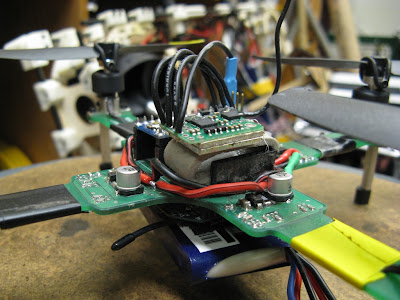It's a Pololu MinIMU-9, featuring an ST L3G4200D 3-axis gyro and LSM303DLM 3-axis accelerometer and magnetometer. This replaces the now-discontinued Sparkfun 6DOF Razor IMU, which had six analog channels (3-axis gyro and 3-axis accelerometer). So, instead of reading each axis into the Arduino Mini's 10-bit ADC, the digital IMU streams 12-bit readings over a 2-wire serial interface (I2C).
The digital IMU has other nice features as well, such as programmable gains, sampling rates, and low-pass filters. No more fidgeting with RC filters on the board. It's compatible with the Arduino Two-Wire Interface (TWI/I2C) library and the sample code on the Pololu page is easy to work with. For once, I must admit that the Arduino I2C stuff does in fact make life easier.
Even with the nice new IMU, 4pcb still seems to suffer from the same vibration problems. I'm not sure why most people are able to get away with just mounting the sensors on some foam but that doesn't seem to be enough for this frame. In order for it to be even flyable, I need to add mass (aluminum) to the back of the IMU board and stick it to a very loose loop of foam tape:
Even the wires connecting the IMU to the main board need to be very flexible high-strand-count wire so as not to transmit vibrations. I should really film it in high speed and be horrified at the amount of high-frequency flexing happening in the frame. It would also be very easy to add stiffeners, though I would have to think about how much I want to compromise on the "entirely made out of a single PCB" goal.
In any case, with the foam loop mounting and carefully-chosen filters, it works:
It's certainly flyable with not much skill and it can stay aloft much longer than in previous testing. The roll axis seems to be more prone to oscillation than the pitch axis, which is something I'll have to look into. I'm not sure it will ever be the type of quadrotor that can sit and hover in one place for an extended period of time with little input from the user. Given its size and minimal sensor set (no GPS, no altimeter), it might always be a little twitchy. But at least it's robust; it's almost never damaged in a crash and even if it is, I have enough spare parts to last forever. And it poses no risk to human life...




it lives! :D
ReplyDeleteYeah now we must combine forces to make a heptarotor!
ReplyDeletePololu MinIMU-9 is very sensitive to vibration. It can not be used on piston engines! Good work
ReplyDelete